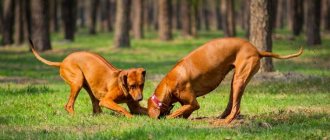Types of fear
Each animal is individual, so it is impossible to describe the entire range of dog phobias at once. However, we can highlight some variants of fear that are most common.
External manifestation of fear
- Street. Often it is the street that becomes the main phobia of an animal, especially when it comes to small dogs like Chikha and Toy. Addressing this fear is vital, and it needs to be done from the very beginning. Without the ability to calmly walk down the street, a dog will not be able to live a full life.
- Other animals. The issue of socialization must be resolved during puppyhood. It will be extremely difficult for a city pet who is afraid of other animals to live in peace. Fear causes a defensive reaction, which manifests itself in aggression, which other dog owners will not like.
- Strangers. Again the question of socialization - domestic dogs should not be afraid of people. Even watchdogs should be able to calmly react to other people if the latter do not pose a threat.
- Noise. Fireworks, fireworks, firecrackers, cars, thunder, thunderstorms - all this is an integral part of city life, but a large number of dog breeders are forced to accustom their pets to these things in order to protect the dog’s life.
- Children. This phobia is often caused by bad experiences between the dog and children. But teaching your dog not to be afraid of children is a prerequisite for ensuring the safety of others.
In addition to these fears, there are many others. However, with an individual approach, you can cure an animal of almost any phobia.
Major phobias
A frightened dog is unable to control its actions. Sometimes animals can show aggression in order to protect themselves from impending danger, and sometimes they even break off the leash if the source of fear is on the street. Or they even run away in panic, including from their own owner. That is why it is important to know what basic phobias exist and try to help your pet overcome them.
Loud sounds
Most often, a four-legged pet experiences fear on an instinctive level when it hears loud sounds, because it associates them with danger. What can we say about dogs, when even people flinch from the roar they hear close to them?
However, a person can determine the source of noise and assess the degree of its danger, but in many cases an animal cannot do this. In a dog, especially at a young age, the noise of fireworks, a running vacuum cleaner, the sound of a pistol shot, fireworks, car alarms, and the clanging of metal can cause a real panic attack.
Phobias can be either congenital or acquired.
Many owners note that thunderstorms cause a particular fear in dogs. The point here is not thunder: pressure changes, lightning flashes and other atmospheric fluctuations increase the load on the animal’s nervous system. At this time, your pet may even lose sleep. In addition, during a thunderstorm, ozone is released, which is the main cause of fear.
Of course, not all animals become phobic of loud noises. Many, as they grow older, become convinced that they pose no danger and simply begin to ignore them.
Important! In some situations, the panic that a dog experiences in front of various noises is a mistake made in education.
So, sometimes owners punish their pets for cowardice, which only strengthens the fear - not so much of the noise, but of the subsequent punishment.
Fear of the stick
It is a known fact that dogs are afraid of sticks in the hands of people. Moreover, fear is observed even if the animal has never been beaten even with a newspaper for an offense. As with the noise, it comes down to the instinct of self-preservation.
When a person holds a stick in his hands, the dog experiences a feeling of visual lengthening of the arm, which is interpreted by the dog as aggression. In nature, animals, in order to scare their opponent, try to appear taller: they raise their fur on end, arch their backs, and begin to jump on their hind legs - in this case, the stick plays the same role.
Important! Some animals take objects waving in front of them as a challenge to fight.
Often people who are afraid of street dogs, not knowing how to scare a dog if it shows aggression, grab a stick, as this is at least some kind of protection. This method, of course, is effective, but only if the animal is not trained.
Fear of sticks is one of the main dog fears.
Strong odors
Due to their developed sense of smell, animals perceive strong odors quite painfully.
The smell of pepper, paint and household chemicals is especially unpleasant for them. If there is a strong concentration of them in the air, for example, when the owner paints a fence or a neighbor in the area does it, the pet can get a burn on the nose, so it is necessary to protect the dog from such objects.
Fire
The fear of fire at the level of instinct is inherent not only in animals, but also in people. The pain from the burn is so severe that it permeates all the cells of the body and is unbearable.
Smart dogs, when they see a fire, simply do not approach it, but some even panic at the sight of a light. Most often, the reason for this appearance is that the dog has previously encountered fire and received a burn.
Important! It is strictly forbidden to frighten an animal with a lighter in case of disobedience.
Other animals and people
This phobia is most often acquired. For example, the owner, being confident that only the forceful method will allow him to raise an obedient dog, uses physical force against him for the slightest offense.
Sometimes the acquisition of such fear by a pet may be due to children who, during the game, without realizing their actions, can cause pain or frighten him, for example, in puppyhood, throwing him into the air or thinking that tickling can entertain him.
It is quite natural that after harsh treatment a dog will be afraid of people and the bite will become its kind of defense. By the way, sometimes a loud scream is enough for an animal to experience fear.
Fear of other animals, as a rule, lies in low socialization. In order for your pet to grow up confident and balanced, it is necessary to allow him contact with other animals from puppyhood.
The owner or an experienced dog handler can help the pet overcome fear.
Ultrasound and stun gun
Ultrasound, which may not be heard by humans, causes discomfort to the animal and therefore it tries with all its might to escape from it. By the way, ultrasonic whistles can scare away a dog, but only if he is not trained or deaf.
As for the stun gun, you should understand that during its operation the smell of ozone is released, which pets associate with bad weather and causes severe horror.
Causes of phobia
Experts have been interested in the issue of dog fear for a very long time. The first place to start correcting unwanted behavior is to identify the cause of its occurrence. Without this, it is impossible to treat a dog for fear of anything.
Hereditary tendency
The dog is afraid of a thunderstorm: what to do and how to calm it down
Fear is innate and is passed on from parents to puppies. Unfortunately, in the modern world this is a very common occurrence. The offspring inherits not only the external qualities of their parents, but also their character traits, behavior and phobias.
Additional Information! Dogs with nervous system problems, timid and fearful individuals are not allowed for breeding.
But it will not be possible to eradicate this problem - a hereditary tendency to fear something is often characteristic of stray dogs that reproduce on their own without hindrance.
Insufficient socialization
It is very easy to spoil even a dog with the most stable nervous system and easy-going character simply by not giving it the necessary upbringing. The process of socialization - learning to live in society - is extremely important and must be controlled from puppyhood.
An unsocialized dog simply does not know the “rules of behavior” among its relatives and does not know how to communicate with them. This is where fear comes from, followed by aggression.
Experienced mental trauma
Unfortunately, a dog can develop a phobia at any age. It is enough to have a bad experience of interacting with the outside world once. For example, city dogs often suffer when firecrackers and firecrackers explode in their legs.
Another clear example is unsuccessful communication with children. Children do not know how to calculate strength, and some of them are prone to unconscious cruelty. The dog, having received such an experience, will be afraid and wary of children. And then he may begin to rush at them in self-defense.
How to help a dog who is afraid of everything?
Posted on February 23, 2021 in Behavior , Fear There are dogs that are afraid of friendly strangers. There are dogs that are afraid of children. There are dogs that are afraid of elevators. And there are dogs that are afraid of everything. Well, or almost everything. If you live with a dog like this, you know what I'm talking about.
Why are some dogs afraid of everything?
Cowardice has two common causes: missed socialization and a weak nervous system. The dogs with missed socialization were completely normal puppies who, by chance, sat in an enclosure or at the dacha for up to 6-8 months. During the period of socialization, they did not get acquainted with the city, its noises and abundance of people, and now all these things seem dangerous to them. And this is reasonable: if you meet a large unfamiliar thing, it is better to run away from it than to be eaten.
Dogs with weak nervous systems were not normal puppies to begin with: their nervous systems are unable to handle large numbers of simultaneous stimuli. This can be compared to a DDOS attack: from the abundance of new impressions, their brain simply “turns off” and no learning occurs. All puppies are afraid of the street at the beginning of their walks, but over time they learn that the street is a fun and safe place. Puppies with a weak nervous system due to the brain being “switched off” from overload cannot learn this, and the street remains a frightening place for them.
What exactly are fearful dogs afraid of?
Both dogs with missed socialization and dogs with a weak nervous system usually feel good in a familiar, quiet place (in an apartment, house, or even a forest). The first is good there because they were initially socialized only with these places, and the second because these places have low stimulation and they were able to learn that these places are good and safe. These dogs are also comfortable with people they know well and with other dogs.
Both of these types of dogs do equally well in a noisy city with an ever-changing environment and an abundance of new stimuli. They may be frightened by cars passing by and honking, screaming children, passers-by suddenly appearing around the corner, distant relatives who have come to visit, and flying packages.
How does a dog who is afraid of everything see the world?
Imagine that your way home runs through a park. There is no way around it. You learned from the news that a maniac is operating in the park and over the past month ten corpses have been found in it. And in the evening you walk through the park. You have become all eyes and ears. You are tense, expecting a possible attack at any second. You walk quickly and quickly to leave this terrible place as soon as possible, and any sudden rustle or movement can put you to flight. This is exactly how a dog who is afraid of the street feels when walking. She is constantly under severe stress. And her owners too.
How can you help a cowardly dog?
Working with a fearful dog takes place in three areas:
- reducing stress levels,
- increased confidence,
- overcoming fears.
These three areas are inextricably linked. You can’t work on one thing and not on the other - there will be no result. Therefore, the exercises are aimed at improving in several areas at the same time.
Exercises I use when working with fearful dogs:
1) Learning to relax on the mat
A dog afraid of the street is constantly tense during a walk, so it is extremely important for him to be able to relax. Usually such dogs relax on their own in a calm environment at home. But some dogs do not know how to relax and need to be taught this (more about training in my article Teaching a Dog to Relax). If you teach your dog to relax on a mat or in a crate tent, you will have a “safety base” (a place where the dog feels calm and comfortable) that you can take with you to a new place (in the car, on a visit) and thus This will help the dog get used to it faster.
2) Mental and physical stress
Since walks are stressful for a dog with a fear of the street, it is worth reducing their volume as much as possible (if the dog is comfortable in the forest and you live near the forest or can bring it there by car, such walks do not need to be reduced). But where will the dog put the accumulated energy? In “good” mental and physical activity.
Mental stimulation includes various search games and food puzzles. A cowardly dog gets “stuck” in perceiving information through his eyes/ears (think of a park with a maniac), which is why it is so important to let him use his nose. In this way, you help the dog relieve excess excitement and teach him a new way of interacting with the world around him.
“Good” physical activity includes various exercises for balance, feeling your body (in particular, the back half), and overcoming obstacles. You can teach your dog to walk backwards, stand on a target with his front paws and circle around it with his back paws, do a bunny run, crawl under chairs, navigate an obstacle course of different surfaces, walk over fallen trees, or slowly and thoughtfully overcome common projectiles. This activity helps reduce overall stress levels and increases your dog's self-confidence.
Good options for mental and physical exercise can be found in Olga Kazharskaya’s book “The Unboring School.”
3) Clicker shaping
Clicker training develops courage and initiative in a dog. We tell her: “don’t be afraid to offer something - it will bring you a reward.” The game “101 actions with a box” is well suited, where the dog receives a reward for each new action in relation to an object (you can see how this looks like in our game with Hans 101 actions with a box). This type of clicker training is especially good for dogs with neophobia (fear of everything new and unusual), since the dog receives a reward for interacting with a new object.
If clicker training seems too complicated for you, you can use a simplified version of it, rewarding the dog for being interested in a new object. You simply place a “scary” new object on the floor, click (or say “yes!”) when the dog becomes curious, and throw a piece of treat away from the object so that the dog can again approach it from afar. What does a dog show interest look like? She approaches the object, stretches out her neck, sniffs, looks attentively, touches it with her paw, tastes it, or even plays. This game increases the dog’s self-confidence, provides mental stimulation and helps fight fears.
4) Meet new people
To combat neophobia, introduce your dog to new sights, smells, sounds and sensations every day. While feeding, play a low-volume audio recording of whales singing or highway noise. When you come home with purchases from the store, let her sniff each of the purchased goods. Walk with it on different types of surfaces. Sit on a stump in the forest away from the path and watch people pass by.
Make sure your dog enjoys meeting new people! Don't rush her or overwhelm her. If she feels anxious, stop the activity immediately. Only positive experiences can overcome fear and instill confidence. Therefore, it is better to do little and end on a good note than to do a lot and end on a bad note.
5) Working with specific fears
When your dog's stress level has decreased, his self-confidence has increased and he enjoys learning new things in a calm environment, you can move on to working on existing fears outside. I will not describe a specific work plan here, because it highly depends on the individual dog: what will help one may harm another. I can only say that the work comes down to changing the association with a thing/phenomenon from fear to joy. This is usually done using the counterconditioning technique or BAT (BAT - Behavior Adjustment Training)
What to do if these exercises don't help?
These exercises are just part of working with a fearful dog. There are also factors such as the dog’s mental characteristics, its past experiences, relationships with its owners and other people. Each case is special, and these exercises are what all these cases have in common. They are part of the solution to a problem, not the whole solution. But with their help, you will definitely make the life of a cowardly dog more comfortable. If you are unable to do some exercises or you understand that they are not enough, contact a specialist who works with fears using positive reinforcement.
Share link:
If the pet is from a shelter
Why does a dog eat its own feces: what to do and how to wean it off
Dog breeders who adopt a pet from a shelter are much more likely to encounter various phobias. As a rule, dogs that end up there rarely leave without a traumatized psyche.
Shelter pets are usually very fearful
The reasons are different - if the dog was handed over to a shelter, most likely this indicates a bad attitude towards it on the part of the first owners. If an animal comes to the shelter from the street, then it has experienced a lot of things and probably also has phobias.
Important! The main problem is that it is impossible to accurately determine the cause of the dog’s fear, since its history is unknown.
Even if you get rid of all the physical problems that shelter dogs suffer from, the dog will not be completely healthy. It is important to competently go through the process of adaptation to a new life, to a new home and owners.
A dog who is afraid to get off the carpet
What to do if a dog attacks a person
Sometimes dog breeders are faced with such a problem that their pet is afraid to get off the carpet and moves around the apartment only on covered surfaces.
The reason for the fear is a physical factor - most likely, the laminate or parquet with which the floor is covered is slippery. The animal, not feeling a solid surface under its feet, rolls around on it, falls, and therefore is afraid to get off the reliable surface - the carpet.
Why is a dog afraid of people?
The reasons for possible fear of people are the same as mentioned above - innate inclination, negative experience, insufficient socialization. However, in addition to this, it is worth considering that each animal is individual.
The pet is afraid of people due to past negative experiences
It may be that the dog is unconsciously afraid of a certain person. The reason for this may even be a low timbre of the voice, high stature, or specific odors emanating from a person, for example, the smell of tobacco smoke.
Manifestation of an inadequate reaction to strangers (aggressive and passive)
Inappropriate behavior of an animal towards a person can manifest itself in the most
in a variety of ways. Dog handlers identify two main behavioral shifts in dogs – aggressive and passive reactions.
The manifestation of one or another form of fear in relation to strangers depends on the individual characteristics of the pet, the type of temperament, and the presence of a negative traumatic factor in the anamnesis.
Melancholic and phlegmatic people by nature will gravitate toward a passive reaction to a stranger in the form of running away. The animal will hide and look for a secluded place when it sees a stranger.
If a pet has a predominant sanguine or choleric type of temperament, then the owner most often faces an aggressive reaction to strangers. Sanguine and choleric people, who are more active by nature, show their fear in the form of barking and sometimes attempts to bite a person.
To learn what to do if your dog is afraid of people, watch this video:
How to stop a dog from being afraid of people: tips and tricks
New dog breeders often wonder: the puppy is afraid of people, what to do. It is important to start socializing your pet from an early age. To do this, you need to gradually bring him out into the public eye. You should not immediately expose your puppy to a large number of people and noises. A good place to start is to take a walk in a less crowded place. Later, when the baby gets comfortable, you can move to livelier places.
In addition to the street, regular visits will be a good experience. The puppy must understand that people are not a source of danger.
For your information! The ideal behavior of a dog with a stranger is considered to be complete ignorance on the part of the animal.
However, it happens that you have to work with an adult dog, which is quite problematic to retrain. In this case, you should first of all protect those around you - put a loose plastic muzzle on the dog and keep it on a leash. Most likely, you won’t be able to do it without the help of a dog handler.
A session with a dog trainer will help solve the problem.
Dog won't accept new pet
York gets along well with all members of the household, provided that he grew up with them and has known them since childhood. If you decide to bring another pet into your home, be prepared for an aggressive reaction. The dog will begin to openly show his hostility towards the new neighbor, be jealous of the owner and
We are waiting for the opportunity to provoke a fight. The owner must show considerable patience in order to calm the dog down and make it clear that now he is not alone in the house.
How to deal with a fearful dog:
- Remember that during times of fear you should not feel sorry for your pet, nor should you scold it. He becomes disoriented and will continue to be afraid next time, in the hope that he will be pitied.
- You are a strong master leader and remain calm. Pretend that you are not afraid of anything, let the dog take an example from you.
- Socialize your dog gradually. First, meet new people.
New acquaintances can come to visit you at home or invite old friends for walks. At the same time, do not focus on your pet. Don’t let him start to show cowardice and think that this is necessary, since there are guests in the house or an old acquaintance with you on a walk.
When the dog gets used to a person, you can ask him to talk to him affectionately, and then bring your hand to his muzzle (hold your palm up), let him sniff and carefully try to stroke him. Gradually begin to communicate with other people, then walk with your dog on a leash in the company of its old acquaintances. If you adopted a dog from a shelter, which is noble, but he is very shy, then even a year may not be enough for him to get used to it and begin to trust people.
A good way of socialization when you take a puppy into a home where there is an older dog. On the street you, and then an acquaintance of the older dog, pet him. The younger one will observe that he likes it and sooner or later he will allow himself to be stroked. The main thing is that the dog is among people every day. Isolation will lead to even greater fear of a person.
Every day 2-4 times or even more, take your pet for walks among people. Start walking in less crowded areas and gradually move to busier ones. As the fruit of your long psychological work on behavior correction, you will soon be able to walk with him even around the market, examining and choosing goods.
When your pet gets comfortable in a city or village, even take him to exhibitions, even if only as a guest. There he will see many relatives.
Ideal holiday with a pet
Agility - sport with your pet
What to do if your dog is afraid of other dogs
Often it is the behavior of the owners that is the cause of dog aggression caused by fear. For example, when an owner sees an unfamiliar dog on the other side of the street, he himself tightens the leash, drags the dog closer to his feet, or tries to choose a workaround. The dog perceives this behavior as fear, and automatically begins to protect the owner and is ready to fight.
Owners should pay attention not only to their pet, but also to their own behavior in a stressful situation. Perhaps the correct reaction on the part of the owner will be the solution to the problem.
Additional Information! In this case, it is best to distract the dog with something positive.
For example, get her interested in a toy or treat. Then she will have no reason to snap and attack her relative.
What to do if the problem cannot be solved
Unfortunately, not every dog can be corrected. Often an adult dog is afraid of something for so long that this fear takes root and becomes part of its nature. In this case, the owner’s task is to learn to live with this himself and teach his dog this.
If your dog is afraid of loud noises, you should not take him to noisy places.
Knowing the subject of an animal’s fear, it is necessary to exclude the possibility of its appearance in life. If this is not possible, then you should at least minimize it. For example, if a dog is afraid of noise, you need to choose walking routes where the risk of running into noisy companies, the hum of cars and teenagers with firecrackers is minimal.
The main mistakes of dog breeders
Not everyone is able to respond correctly to a pet's fear. Inexperienced owners sometimes misperceive aggression caused by fear. The main mistake dog breeders make is punishing the dog for its fears.
Under no circumstances should you scold, beat or otherwise negatively influence an animal if the dog is afraid of everything. The owner must remain calm and help the dog survive stressful situations with the least damage to his psyche.
If the owner practices punishment for fear for a long time, the animal can become truly aggressive. This leads to the destruction of contact between the pet and the owner, mistrust, and even aggression towards the owner himself.
Important! If an animal becomes downtrodden and angry, it is very difficult to correct this problem.
Specialist help
Owners should sensibly assess their strengths. In some situations it will not be possible to do without outside help. In this case, you should contact a competent dog handler. It is important to understand that the specialist does not work with the dog. Its task is to teach the owner to interact with his pet. Some specialists are known in several countries at once, such as Antoine Najarian.
Help from a dog handler is quite an expensive pleasure. But should you make a choice: doom your dog to a life of constant fear, or go with it to a dog handler for a while, spend money, but gain peace and mutual understanding? Everyone decides this for themselves.
A dog's fear is not a fatal vice. Some dogs can be trained not to be afraid, while others will have to be protected from the objects of their fear. In any case, the main thing is to give the animal love and affection.
Toy terrier is afraid of other dogs
- Remember that going outside for the first time is a kind of stress for a dog. Therefore, if you notice that your toy terrier is afraid of other dogs, pick him up. This way he will feel more confident and quickly get used to the atmosphere of the street.
Understands stress for the first time
- Gradually he will run more and more on his own, and this will be a good time to start meeting other dogs.
- The main thing is to start friendships with small and non-aggressive dogs, praise him for every sniff and play. And remember, you can’t raise a dog without patience and affection.











